Natural heat sources like sunlight provide gentler, more consistent heating that helps release spice compounds gradually and completely. You'll get deeper, more nuanced flavors compared to harsh artificial heat, which can scorch delicate essential oils. Traditional methods across Asia and the Mediterranean have long relied on solar heat for blooming spices, as it preserves the subtle aromatic notes while maximizing flavor potential. The sun's natural warmth also aligns with sustainable practices and creates ideal conditions for the fat-soluble compounds in spices to fully develop. Understanding these time-tested techniques can transform your approach to spice preparation.
The Chemistry Behind Solar Blooming
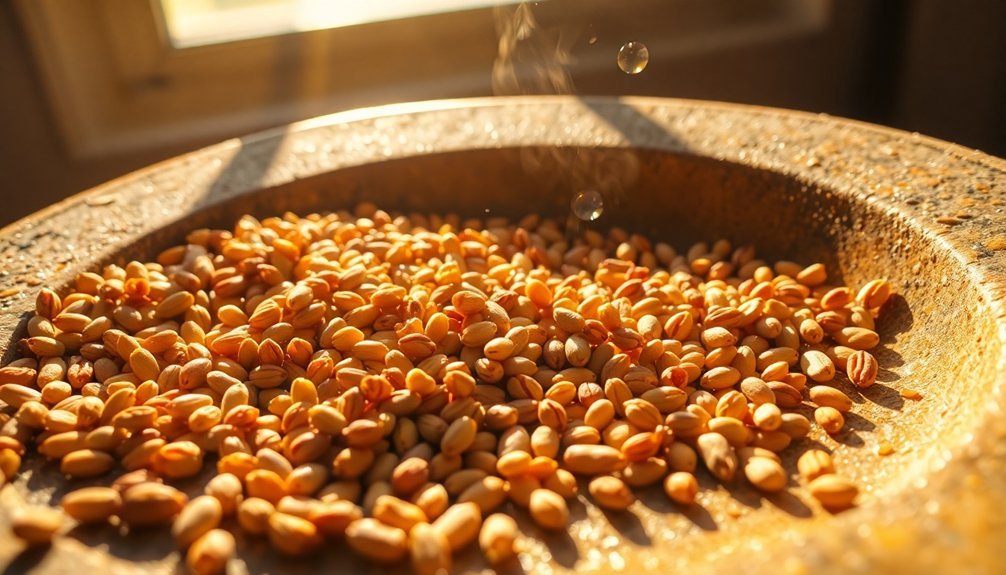
When spices meet hot oil, a remarkable chemical transformation occurs that releases their full flavor potential.
You'll notice how fat-soluble compounds within the spices begin to dissolve and disperse, intensifying both their aroma and taste. This process makes spices taste more authentically like themselves.
Your choice of oil is essential – you'll want one with a high smoke point to avoid burning these delicate compounds. Native to regions like Jamaica and India, many baking spices developed their distinct characteristics through natural heat exposure in their tropical climates.
The process isn't just about heating; it's about creating the perfect environment for flavor extraction. When you bloom spices in oil, you're actually protecting volatile compounds that would otherwise escape into the air.
This chemical reaction guarantees you'll get maximum flavor distribution throughout your dish, making each bite consistently flavorful and aromatic.
Solar Heat Versus Artificial Heat
Understanding heat sources for spice blooming goes beyond the traditional stovetop method. When you're choosing between solar and artificial heat, you'll find distinct advantages to each approach.
Solar heat offers a gentle, sustainable way to release your spices' flavors. You're tapping into a renewable energy source that's environmentally friendly and cost-effective. While it's weather-dependent, solar heat provides a more homogeneous warming process that can enhance the natural blooming of spices without the harsh exposure often associated with artificial heat sources. This method helps preserve essential oils and flavors throughout the drying process.
Artificial heat, while more controllable and consistent, relies on non-renewable energy sources and can be less forgiving. You'll get predictable results, but you might miss out on the subtle flavor development that solar heat's gradual warming process provides.
The key difference lies in the heat distribution and intensity levels.
Traditional Spice Preparation Methods
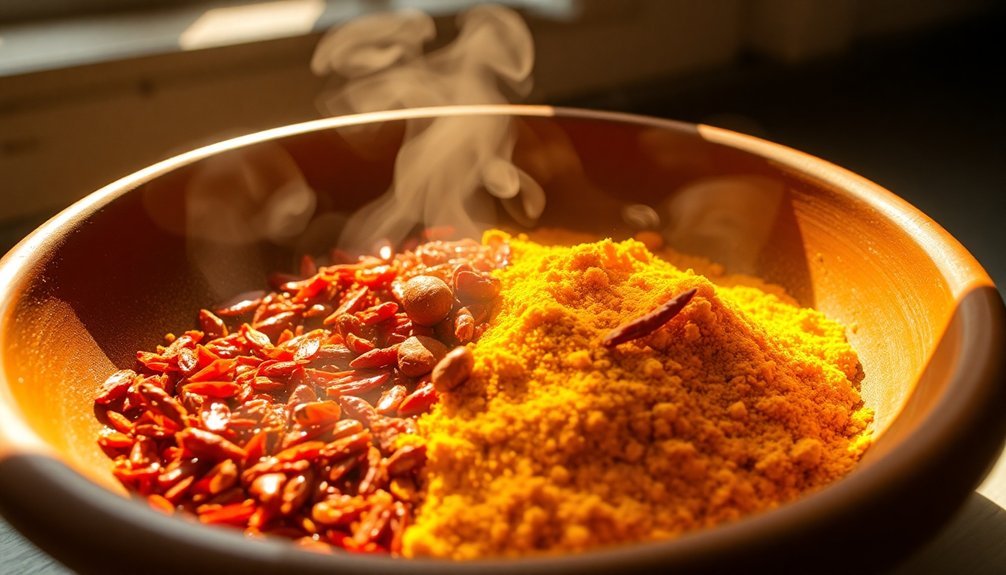
Traditional spice preparation stands as one of the most time-honored culinary practices, where each spice demands its own unique handling method.
Quality spices require specific climate conditions to develop their distinctive flavors and aromas.
You'll find that each spice requires distinct harvesting techniques – from hand-picking black pepper berries to carefully collecting saffron stigmas.
The drying process varies considerably: while you can sun-dry black pepper and cinnamon, you'll need to shade-dry delicate saffron. For turmeric, you'll want to boil the rhizomes before sun-drying.
When it comes to final preparation, you can enhance flavors through proper roasting techniques.
Whether you're using a stovetop or oven method, you'll need to maintain even heat distribution and watch for that telltale aroma.
Remember to stir frequently and look for slight color changes that indicate your spices have reached their peak flavor potential.
Optimal Temperature Control Points
Building on these traditional preparation methods, precise temperature control emerges as the cornerstone of spice cooking.
You'll want to start with medium-low heat for small pans and medium heat for larger ones, using high smoke point oils like canola or ghee.
Begin by adding whole spices that can handle higher temperatures, such as mustard seeds, followed by cumin and fenugreek once the initial seeds pop.
As you add warming spices like cinnamon and cardamom, watch for their toasted appearance and swirl the pan for even cooking.
Turn off the heat before adding ground spices, which can burn quickly.
You'll know you're on the right track when you smell nutty, smoky aromas.
Remember to monitor cooking times carefully – most spices need only 30 seconds to two minutes to release their full flavors.
Sunlight's Effect on Flavor Compounds
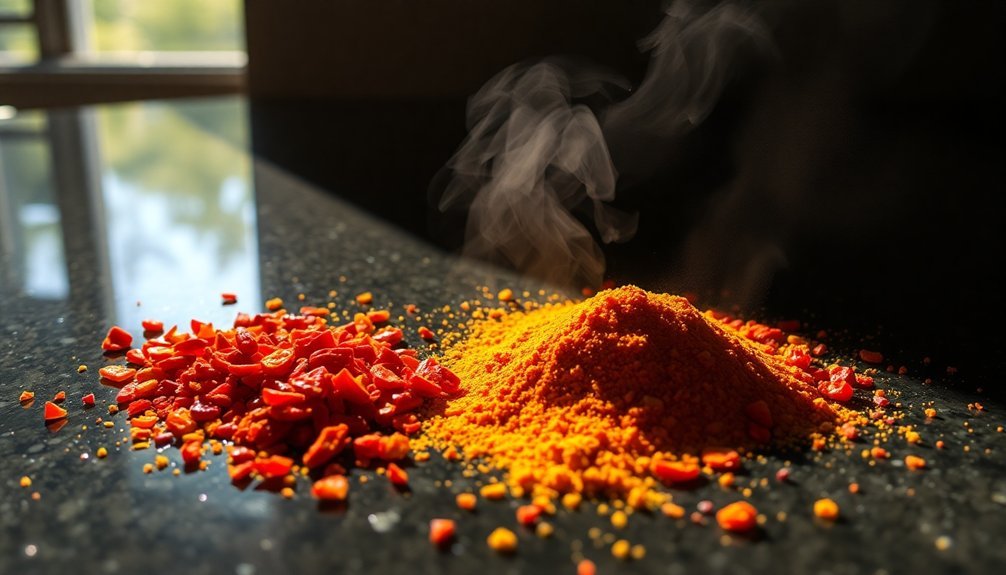
Nature's delicate interplay between sunlight and spices creates the vibrant flavors we treasure in our cooking.
You'll find that sunlight plays a vital role in developing the volatile compounds that give spices their distinctive aromas and tastes.
When you're cooking with spices from tropical regions, you're experiencing the results of ideal sun exposure. The warm sunshine triggers the accumulation of essential oils and flavor compounds, like capsaicin in chilies and thymol in thyme. These compounds readily evaporate at low temperatures, releasing their aromatic properties.
You'll notice that spices from different regions offer unique flavor profiles based on their sun exposure. High-altitude areas with abundant sunshine produce intensely flavored spices like saffron, while temperate climates create the balanced profiles found in nutmeg and peppercorns.
Essential Oils and Solar Release
You'll find that essential oils release differently when exposed to natural sunlight versus artificial heat, creating unique extraction patterns in spices and herbs.
The sun's gradual warming helps protective plant membranes open slowly, allowing volatile compounds to emerge without the harsh breakdown that occurs with conventional heat methods.
Solar extraction proves particularly effective with aromatic spices like cloves and cinnamon, where you'll get yields comparable to traditional methods while preserving more of the delicate flavor compounds.
Sun-Activated Flavor Release
While traditional extraction methods rely heavily on artificial heat sources, a groundbreaking Solar Energy-Based Extraction System (SEE) has revolutionized how we harvest essential oils from spices and herbs. You'll find that SEE's ideal performance kicks in at 1000 W/m² of solar radiation, delivering yields comparable to traditional methods.
| Plant Type | Extraction Rate | Yield % | Dominant Compounds | Days to Extract |
|---|---|---|---|---|
| Oregano | 3.4 ml/day | 45% | Terpenes | 4 |
| Clove | 2.9 ml/day | 58% | Oxygen | 5 |
| Cinnamon | 2.5 ml/day | 52% | Oxygen | 6 |
| Cardamom | 2.2 ml/day | 48% | Oxygen | 7 |
| Rose Petals | 1.8 ml/day | 18.5% | Terpenes | 9 |
You'll appreciate how this sustainable method preserves thermolabile compounds while being 23-34% greener than traditional approaches, making it perfect for small-scale production in rural settings.
Thermal Extraction Benefits
Modern thermal extraction methods offer distinct advantages for harvesting essential oils, particularly when combining traditional heat-based techniques with solar energy systems.
You'll find that controlled temperatures play an essential role in maximizing extraction efficiency while preserving delicate compounds.
When you're working with essential oils, you can use different extraction methods to achieve specific results.
Supercritical CO2 extraction lets you selectively target compounds by adjusting temperature and pressure, while ethanol extraction preserves sensitive aromatic molecules better than steam distillation.
You'll get the best results by matching the extraction method to your spice's characteristics.
Whether you're using microwave-assisted extraction for quick, uniform heating or enzyme-assisted processes for gentle compound release, you're able to maintain the natural flavors and aromas that make spices uniquely valuable.
Time and Temperature Relationships
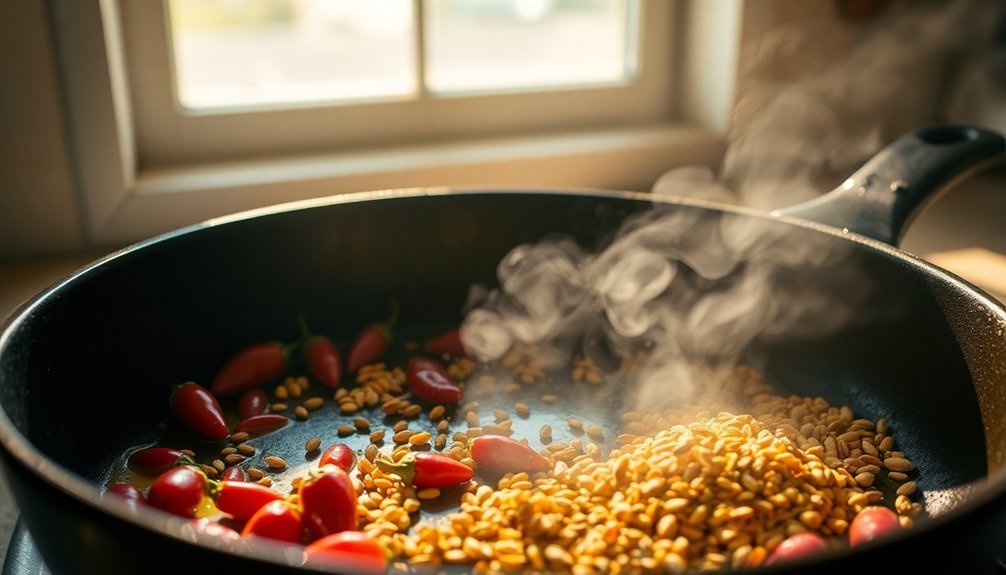
Since timing and temperature work together in perfect harmony, mastering their relationship is essential for blooming spices effectively.
You'll want to start with medium to medium-low heat and bloom your spices at the beginning of cooking. A brief 30-second heating is typically enough to release those flavor-packed oils.
Watch your temperature carefully – high heat's a quick route to bitter, scorched spices.
For delicate spices like saffron, you've got options: use hot water for a 5-15 minute bloom, or try the ice cube method for a gentler 30-40 minute process.
When blooming in oil or fat, you'll get better flavor distribution, but keep monitoring closely.
Solar Blooming Equipment Setup
A successful solar blooming setup relies on simple but strategic equipment choices. You'll need light-colored vessels like cookie sheets or drying racks that won't cause your spices to burn. Position these facing south to maximize sunlight exposure, and guarantee you're using clean, dry mason jars for any oil infusions.
| Equipment Type | Best Practice |
|---|---|
| Vessels | Light-colored, shallow |
| Containers | Clean mason jars |
| Screens | Fine mesh, elevated |
| Racks | Even spacing design |
| Trays | Flat, well-ventilated |
For best outcomes, you'll want to create a solar oven effect by closing windows to trap heat. Set up your herbs in a single layer, avoiding overlap to guarantee even drying. You can use this setup for both drying herbs and creating infused oils, maintaining temperatures below 130 degrees for oil infusions.
Regional Spice Blooming Practices
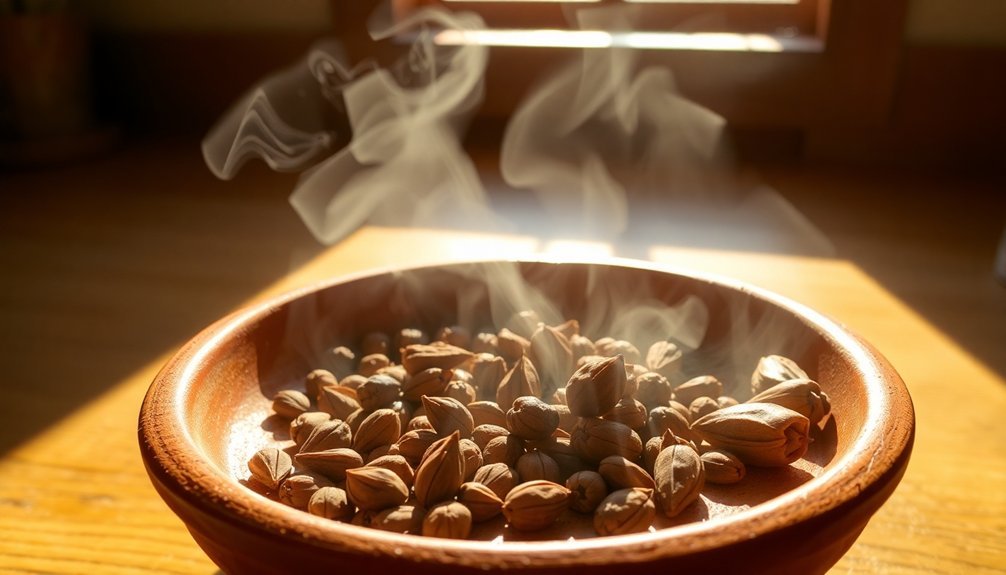
Throughout diverse culinary traditions worldwide, spice blooming practices reflect distinct regional characteristics and cultural preferences.
In the Indian subcontinent, you'll find variations like vaghar and tadka, where ghee serves as the primary fat for blooming cumin, fenugreek, and mustard seeds. Mediterranean cooks rely on olive oil to bloom herbs like thyme and rosemary, while Middle Eastern cuisine emphasizes cumin, coriander, and sumac for dishes like shakshuka.
Regardless of region, you'll want to follow key principles: choose high smoke point fats, add ingredients in the right order (fresh aromatics first, then whole seeds, followed by ground spices), and maintain medium to low heat.
Deep pans with high walls work best, protecting you from oil splashes while ensuring even heat distribution.
Sustainable Flavor Enhancement Techniques
You'll find that traditional low-heat blooming methods extract maximum flavor from spices while using minimal energy resources.
By gently heating your spices in oil over low flames or using residual cooking heat, you're not only developing deeper flavors but also practicing energy-efficient cooking techniques.
These sustainable approaches to spice extraction let you harness rich, complex tastes while reducing your environmental impact in the kitchen.
Traditional Low-Heat Methods
Traditional low-heat methods for enhancing spice flavors combine time-tested techniques with sustainable practices, offering both culinary excellence and environmental benefits.
You'll find that heating spices in oil releases fat-soluble compounds, creating deeper flavors in dishes like cacio e pepe and chili.
By blooming your ground spices in oil before adding liquids, you're maximizing their flavor potential while preventing scorching. This technique works particularly well with spices like cumin and coriander.
For milder options, you can use organic Mediterranean seasonings or salt-free blends that provide aromatic complexity without intense heat.
These methods align perfectly with sustainable agroforestry practices, which maintain soil health and reduce carbon emissions.
When you crush dried herbs between your fingers, you're not just releasing essential oils – you're participating in a climate-friendly cooking approach.
Energy-Efficient Spice Extraction
While traditional spice extraction often relies on heat-intensive methods, modern sustainable techniques offer remarkable efficiency in drawing out flavors and compounds.
You'll find that ultrasound-assisted extraction breaks down plant cell walls using high-frequency sound, while microwave technology heats spices quickly and uniformly to preserve delicate aromas.
If you're looking for exceptional purity, supercritical fluid extraction using CO2 lets you adjust pressure and temperature to target specific compounds without leaving harmful residues.
When you need to enhance extraction efficiency further, enzyme-assisted methods naturally break down plant materials without harsh chemicals.
These green technologies aren't just environmentally responsible – they're also faster and more energy-efficient than conventional methods.
You can even combine them for better results, ensuring your spices retain their nutritional value and flavor profiles.
Preserving Spice Potency Through Sunlight
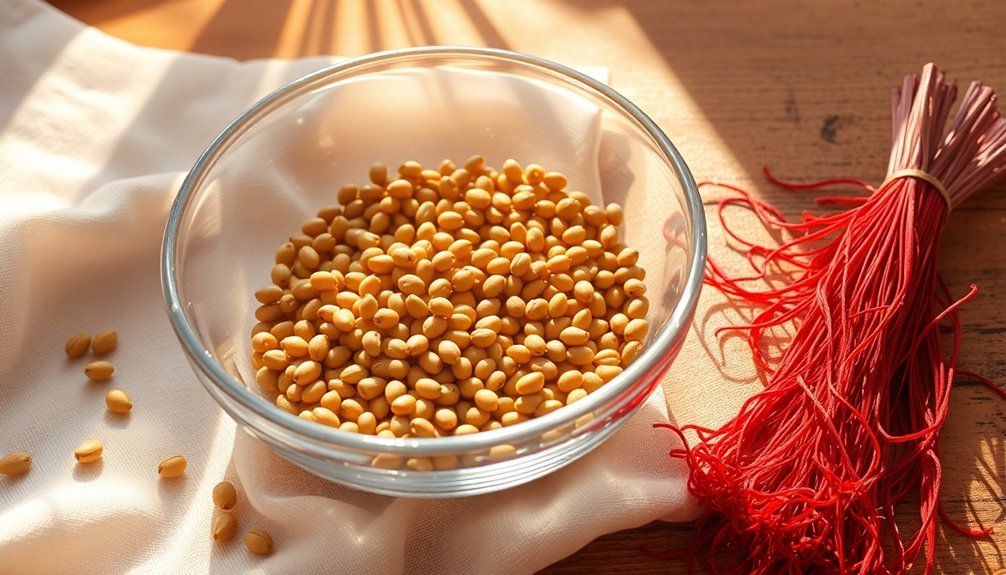
Despite popular misconceptions about sun-drying herbs and spices, direct sunlight actually diminishes their potency and quality. When you expose your spices to light, their essential oils break down, causing them to lose their vibrant flavors and aromas.
This is particularly true for pigmented spices and leafy herbs, which oxidize quickly under sunlight.
To maintain your spices' potency, you'll want to store them in dark, cool places like cabinets or pantries. Consider using dark-colored glass bottles and airtight containers to protect them from light damage.
While whole spices typically last longer than ground ones, even they'll fade considerably after five years. You can track their freshness by labeling containers with dates and regularly checking their aroma.
Solar Kitchen Best Practices
Successful solar cooking relies on proper equipment selection and technique. You'll want to choose dark cookware like Granite Ware pots to maximize heat absorption, and use lidded dishes to retain moisture. Pre-heat your solar oven for 15-20 minutes and keep it aligned with the sun throughout cooking.
| Best Practice | Equipment | Safety |
|---|---|---|
| Choose flat, sunny spot | Dark cookware | Use pot holders |
| Monitor internal temp | Covered dishes | Check food temp |
| Adjust angle frequently | Thermometer | Maintain cleanliness |
For ideal results, select recipes suited for moist-heat cooking methods. While solar ovens excel at baking and stewing, they're less effective for browning. You'll need to adapt cooking times based on weather conditions and your specific oven design. Keep testing and adjusting through experience – solar cooking enhances natural flavors while preserving nutrients through gentle, slow cooking.
Frequently Asked Questions
Can Spices Bloom Effectively on Cloudy Days or During Nighttime Hours?
You can effectively bloom spices during cloudy days or nighttime hours since the process relies on heat from cooking fat, not natural light. The technique works anytime as long as you've got proper heat control.
Does UV Radiation Affect the Nutritional Content of Solar-Bloomed Spices?
Yes, UV radiation affects your spices' nutrition when blooming. You'll find increased antioxidants, phenolic compounds, and essential oils. However, too much UV exposure can damage some nutrients, so it's best to monitor blooming time.
How Does Altitude Impact the Solar Blooming Process of Different Spices?
You'll find altitude greatly affects spice blooming through varying UV radiation, temperature, and moisture levels. Higher elevations offer intense sunlight but challenging cold conditions, while mid-altitudes typically provide the best blooming environment.
Which Container Materials Are Safest for Solar Blooming of Spices?
You'll find glass, stainless steel, and food-grade ceramic containers are your safest options for solar blooming spices. They're non-reactive, won't leach chemicals, and maintain proper ventilation when properly designed.
Can Seasonal Changes Alter the Effectiveness of Solar Spice Blooming?
Yes, you'll find seasonal variations greatly impact solar spice blooming. You'll need longer exposure in winter months, while summer's intense heat requires shorter times and careful monitoring to prevent flavor loss.
In Summary
You'll find that natural sunlight provides the ideal environment for blooming your spices. By embracing traditional solar heating methods, you're not only conserving energy but also maximizing flavor compounds in a way artificial heat can't match. Remember to control your exposure times and temperatures carefully. When you use the sun's gentle, consistent warmth, you'll achieve deeper, more complex flavors while maintaining your spices' natural potency.


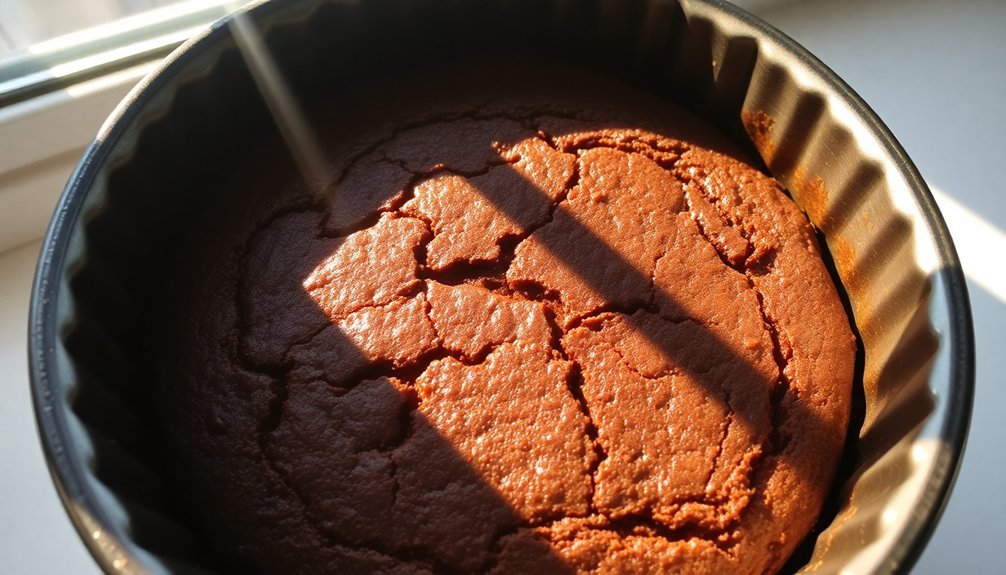
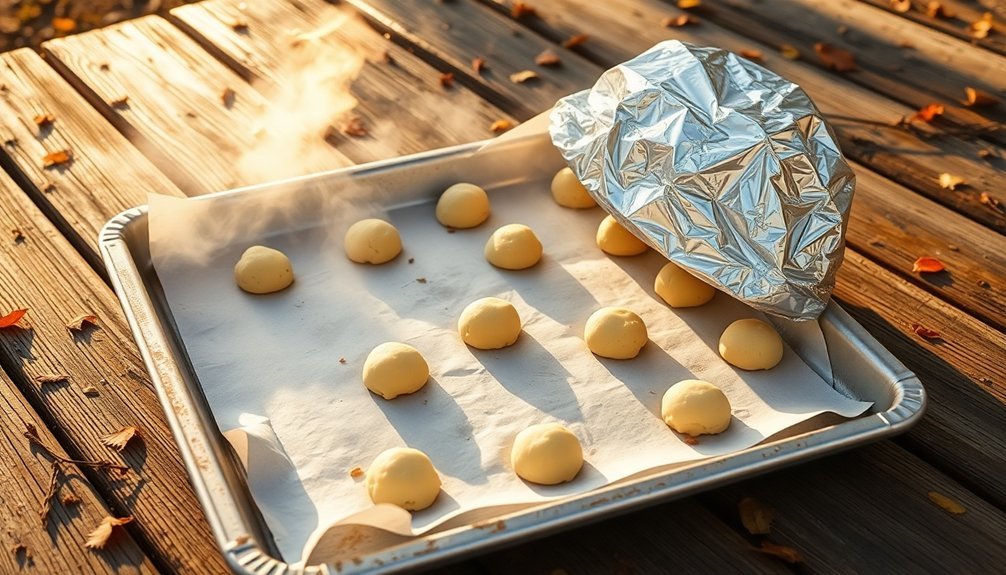
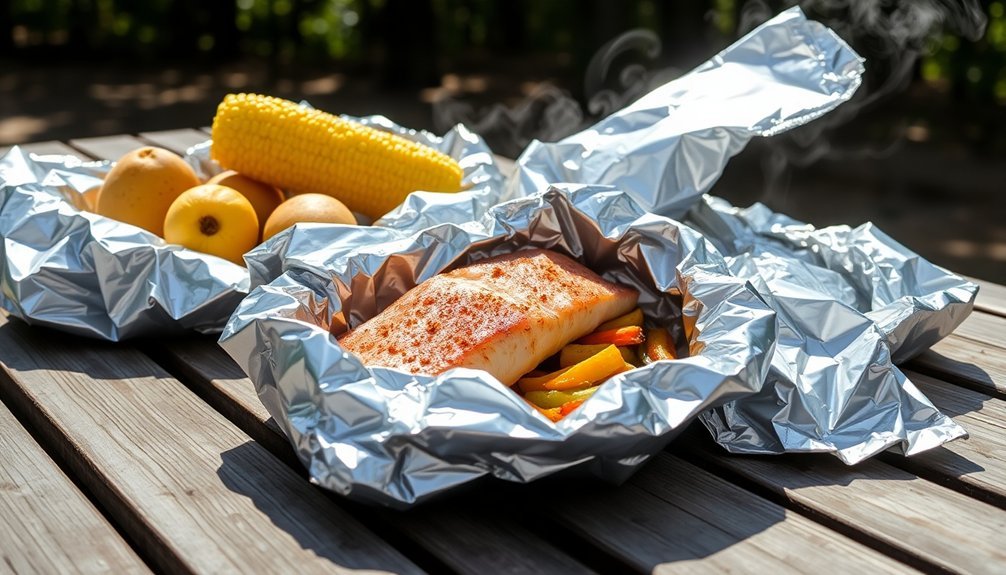
Leave a Reply